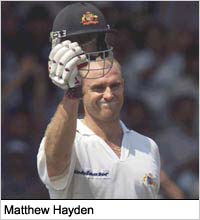It's a bowler's game
Daniel Laidlaw
Test cricket is a bowler's game. If you question that, you need only look at
the strongest teams of the present or recent past: Australia, featuring
McGrath, Gillespie and Warne; South Africa, boasting Donald and Pollock as
their spearheads; Pakistan, with Wasim and Waqar in their pomp; back to West
Indies with Ambrose and Walsh as the last of a great chain of (fast) bowlers
who made those teams dominant.
Several factors make up a successful team but the common element they all
share is a high quality bowling attack. This basic truth is a shade too
easily forgotten when it comes to assessing why a particular team won or
lost or what makes a side strong. Exciting or consistent batsmen tend to
attract their fair share of the limelight, captains in charge of winning
sides are invariably praised for their tactical acumen (and vice versa when
they lose) and any number of individuals are naturally lauded for their
exploits. Yet it is the assembly of a quality bowling group that is crucial
to success.
 If you were to pick a hypothetical team from scratch, the first type of
player you would want to select is a champion bowler. To put it bluntly, in
a team starting from nothing you would pick McGrath ahead of Tendulkar. It
is the nature of Test cricket that bowlers are inherently more valuable to
their teams than batsmen. There are typically only four of them compared to
six specialist batsmen, so immediately their roles become more critical to
the outcome of any game.
If you were to pick a hypothetical team from scratch, the first type of
player you would want to select is a champion bowler. To put it bluntly, in
a team starting from nothing you would pick McGrath ahead of Tendulkar. It
is the nature of Test cricket that bowlers are inherently more valuable to
their teams than batsmen. There are typically only four of them compared to
six specialist batsmen, so immediately their roles become more critical to
the outcome of any game.
It is one of cricket's biggest clichés that "you need 20 wickets to win a
match" but it became so because it is true. Two teams featuring a glittering
array of batting talent will not achieve anything better than draws if they
field mediocre bowlers incapable of bowling the opposition out twice. In
contrast, no matter how feeble a batting line-up a team might possess, it
will always stand a chance of victory with a powerful bowling attack.
Some people blame Tendulkar for not winning enough matches for India. Short
of developing into a genuine all-rounder, what can he do? Tendulkar is
principally a batsman, not a bowler. He, as with all batsmen, is responsible
for generating totals large enough for the bowlers to defend. Occasionally,
a batting line-up will be required to achieve a large fourth-innings target
if the bowlers let them down, but successful chases are still rare. By and
large the guys with the ball are the match-winners.
Top-class batsmen can elevate good teams to great ones and great ones into
even higher echelons by rescuing matches that would otherwise have been
lost. Adam Gilchrist has done this with Australia to some extent. But it is
rare to find any sort of moderately successful team without a respectable
attack. Sri Lanka have risen on the performances of Muralitharan and his
support cast. Simply, batsmen cannot sustain a side long enough for it to be
consistent without bowling firepower. India away from home, at least prior
to the present series, comes to mind here.
An under-rated facet of Test cricket is the importance of bowling in
partnerships. Everyone recognises that partnership-building is the key to
batting, but it is less true on the bowling front, where the protagonists
tend to be viewed more individualistically. In a team game of patience and
pressure, this attitude is somewhat misplaced. Successful bowling
partnerships, and the pressure they apply, are significant.
 In the six Tests played between Australia and South Africa in the season
just gone, South Africa used no less than 12 different bowlers, including
six different new ball combinations. Now, the pressure the dominant
Hayden/Langer opening combination applied to South Africa's attack from the
outset was crucial, but from a bowling perspective the inability to find a
consistent posse of bowlers able to perform in pairs was decisive, and the
whole attack suffered. Cameo performances by Ntini and Adams in South Africa
came to nothing without adequate support. In contrast, Australia used only
six bowlers through the six Tests, and the pressure they sustained in pairs
was telling. The difference was also a reflection of the mentality of the
two sides, but at a basic level bowling partnerships were a key difference.
In the six Tests played between Australia and South Africa in the season
just gone, South Africa used no less than 12 different bowlers, including
six different new ball combinations. Now, the pressure the dominant
Hayden/Langer opening combination applied to South Africa's attack from the
outset was crucial, but from a bowling perspective the inability to find a
consistent posse of bowlers able to perform in pairs was decisive, and the
whole attack suffered. Cameo performances by Ntini and Adams in South Africa
came to nothing without adequate support. In contrast, Australia used only
six bowlers through the six Tests, and the pressure they sustained in pairs
was telling. The difference was also a reflection of the mentality of the
two sides, but at a basic level bowling partnerships were a key difference.
For all the attention rightly afforded elite batsmen and their craft, for me
the most intriguing aspect of Test cricket is the capture of wickets. This
is primarily because they instantaneously alter the state of the game more
than any single shot can. Batsmen require time to exercise an influence;
bowlers need only an inspired burst and with that are capable of exerting a
greater individual influence over a match.
In years to come, what will be remembered most about the 2001 Australia v
India series is Laxman's 281 and his partnership with Dravid in the second
Test. But were it not for Harbhajan Singh engineering the Aussie collapses
with his 32 wickets, their heroics ultimately would not have altered the
course of the series.
Without question, batsmen can lose games. India being bowled out for 102 on
the first day effectively demonstrated that. But it is still bowlers who
chiefly win them. In the second Test at Port-of-Spain, it was not Tendulkar's hundred nor Laxman's half-centuries that won India the match. It was the
efforts of Srinath, Nehra and Khan in twice dismissing West Indies for below
300, particularly Nehra's double-strike in the second innings. Laxman may
have been the man of the match, but Nehra was the MVP.
It is seen as a batsman's game and on perceptions, aesthetics and the
ability to draw crowds it probably is. It's true that Muralitharan v McGrath
does not excite the imagination in the same way as Lara v Tendulkar.
Nevertheless, it is the bowlers who really influence it.
More Columns
Mail Daniel Laidlaw